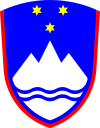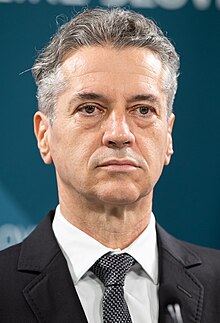
Back رؤساء وزراء سلوفينيا Arabic Primer Ministru d'Eslovenia AST Министър-председател на Словения Bulgarian Premijer Slovenije BS Primer Ministre d'Eslovènia Catalan Předseda vlády Slovinska Czech Sloveniens premierministre Danish Ministerpräsident (Slowenien) German Presidente del Gobierno de Eslovenia Spanish Slovenian pääministeri Finnish
| President of the Government of the Republic of Slovenia | |
|---|---|
| Predsednik Vlade Republike Slovenije | |
 Flag of the Prime Minister of Slovenia | |
| Government of Slovenia Office of the Prime Minister | |
| Style | Mr Prime Minister (formal) President of the Government (Slovene: Gospod predsednik vlade) Mr President (informal) (Slovene: Gospod predsednik) His Excellency (diplomatic) (Slovene: Njegova ekscelenca) |
| Type | Head of government |
| Member of | Government of Slovenia European Council (EU) Euro summit (EU) National Security Council North Atlantic Council (NATO) |
| Reports to | National Assembly |
| Residence | None |
| Seat |
|
| Nominator | President |
| Appointer | National Assembly |
| Term length | No term limit |
| Constituting instrument | Constitution of Slovenia |
| Inaugural holder | Lojze Peterle |
| Formation | 16 May 1990 (de facto) 23 December 1991 (de jure) |
| Salary | €76,586 annually[2] |
| Website | www.vlada.si/predsednik_vlade |
 |
|---|
|
UN Member State |
The prime minister of Slovenia, officially the president of the Government of the Republic of Slovenia (Slovene: Predsednik Vlade Republike Slovenije), is the head of the Government of the Republic of Slovenia. There have been nine officeholders since the country gained parliamentary democracy in 1989 and independence in 1991.
The prime minister of Slovenia is nominated by the president of the republic after consultation with the parties represented in the National Assembly. He is then formally elected by a simple majority of the National Assembly. If no candidate receives a majority, a new vote must be held within 14 days. If no candidate receives a majority after this round, the President must dissolve the legislature and call new parliamentary elections unless the National Assembly agrees to hold a third round. If no candidate is elected after a third round, then the legislature is automatically dissolved pending new elections. In practice, since the appointee must command a majority of the National Assembly in order to govern, the appointee is usually the leader of the majority party in the National Assembly or the leader of the senior partner in the governing coalition. The National Assembly can only withdraw its support from a prime minister by way of a constructive vote of no confidence–that is, a motion of no confidence is of no effect unless a prospective successor has the support of a majority. The prime minister is also the president of the National Security Council.
© MMXXIII Rich X Search. We shall prevail. All rights reserved. Rich X Search
